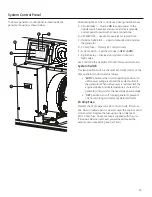
13
the information below is provided to assist gaseous fuel
system technicians in planning installations. in no way
should this information be interpreted to conflict with
applicable fuel gas codes. consult with your local fuel
supplier or fire Marshall if questions or problems arise.
to the instaLLer:
Consult with the home generator
owner(s) and convey any technical considerations that
might affect their installation plans before applying these
general guidelines.
The following general rules apply to gaseous fuel
system piping:
• The piping should be of a material that conforms
to federal and local codes, rigidly mounted and
protected against vibration.
• Piping should be protected from physical damage
where it passes through flower beds, shrub beds, and
other cultivated areas where damage could occur.
• Install the flexible, gaseous hose (supplied) between
the home generator Fuel Inlet port and rigid piping
to prevent thermal expansion or contraction from
causing excessive stress on the piping material.
note
: Where local conditions include earthquake, tornado,
unstable ground, or flood hazards, special consideration
shall be given to increase strength and flexibility of piping
supports and connections.
the Gaseous fuel system
• Piping must be of the correct size to maintain the
required supply pressures and volume flow under
varying generator load conditions with all gas
appliances connected to the fuel system turned on
and operating.
• Use a pipe sealant or joint compound approved for
use with NG/LPG on all threaded fittings to reduce the
possibility of leakage.
• Installed piping must be properly purged and
leak tested, in accordance with applicable codes
and standards.
consider the following factors when planning the fuel
supply system installaton:
• Air density is less at high altitudes, resulting in
less available engine power. See
Power Decrease
at High Altitude or High Temperature
in the
operator’s manual.
• A minimum of one accessible, approved manual
shutoff valve shall be installed in the fuel supply line
within 6 ft (1.8 m) of the home generator. A union or
flanged connection shall be provided downstream
from this valve to permit removal of controls.
• Both LP vapor and natural gas fuel supply pressure
at the generator’s fuel inlet port should be between
7 to 11 inches of water (in. W.C.) at full load with all
gas appliances turned on and operating.
The generator has been factory load tested to run on either
natural gas or LP vapor fuel. The unit can be converted from
natural gas to LP vapor or vice versa using two people and
special tools. See
Fuel Conversion
, later in this manual.
WarninG
Propane and Natural Gas are extremely flammable
and explosive.
Fire or explosion can cause severe burns or death.
LP gas is heavier than air and will settle in low areas.
•
Natural gas is lighter than air and will collect in high areas.
•
The slightest spark can ignite these fuels and cause an explosion.
•
DO NOT light a cigarette or smoke.
•
caution
The supplied flexible gaseous pipe is not to be
installed underground or in contact with the ground.
The entire flexible gaseous pipe must be visible for periodic
•
inspection and must not be concealed within nor contact nor run
through any wall, floor, or partition.
WarninG
Propane and Natural Gas are extremely flammable
and explosive.
Fire or explosion can cause severe burns or death.
Before placing the generator into service, the fuel system lines
•
must be properly purged and leak tested.
No leakage is permitted.
•
Содержание 45000
Страница 1: ...GE Home Generator Systems 45000 Watt Home Generator System Installation and Start Up Manual ...
Страница 24: ...24 Schematic Diagram ...
Страница 25: ...25 Wiring Diagram ...














































